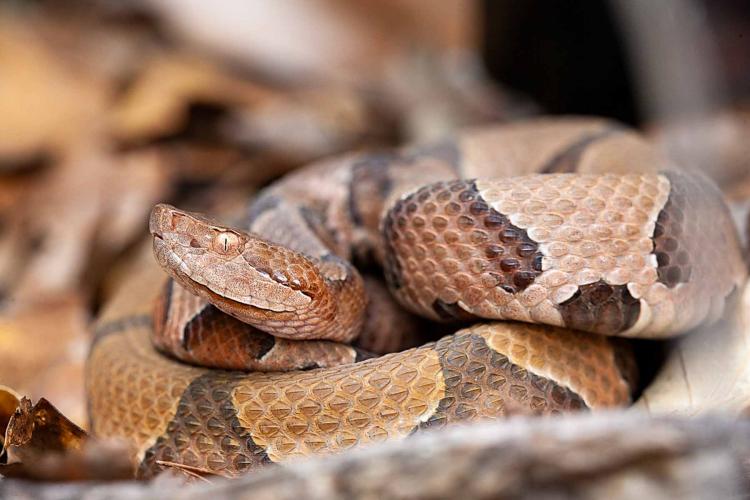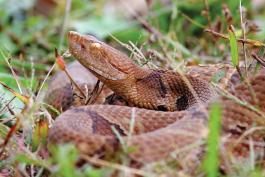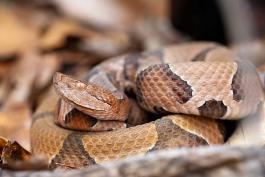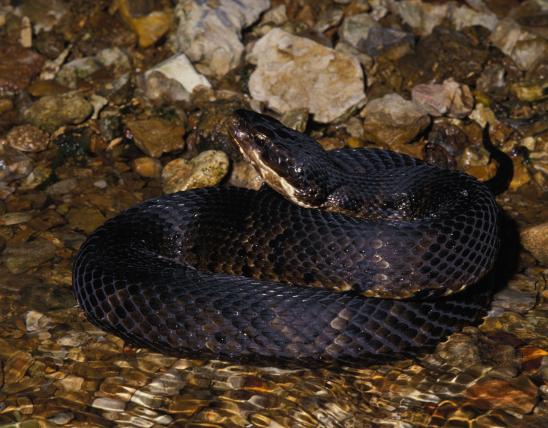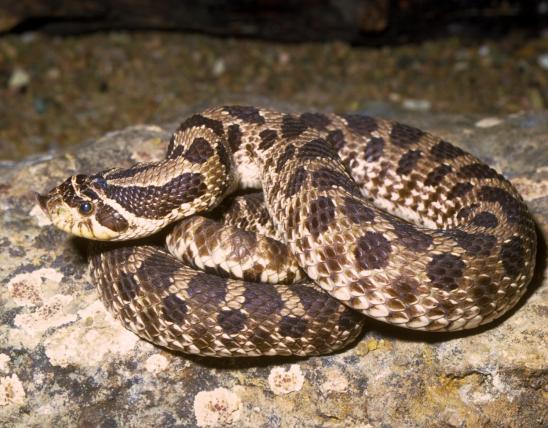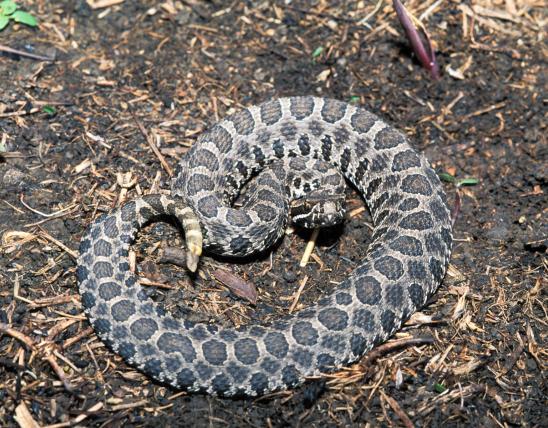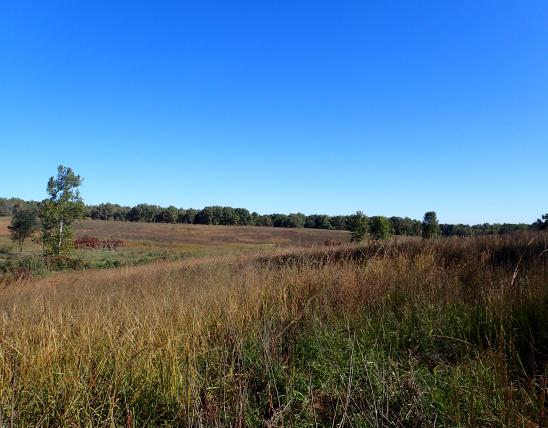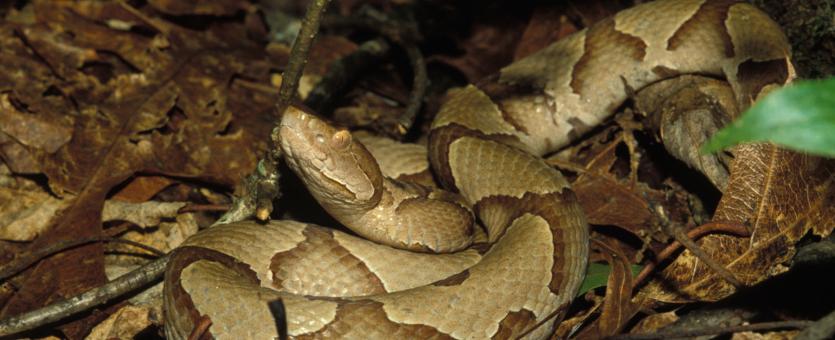
The eastern copperhead is a medium-sized, stout-bodied snake with a sensory pit (heat-sensing pit) between each nostril and eye. It is gray, copper, tan, or pinkish tan with hourglass-shaped bands of dark brown. The markings are often edged in white. The top of the head can be gray or tan and without any markings. The eyes have vertical pupils. The belly is cream colored with large, dark gray or brown blotches along the edges that extend partly onto the sides of the body. Young eastern copperheads and some adults have a yellow tail tip. The scales along the back are weakly keeled, and the anal plate is single.
The eastern copperhead is the most common venomous snake in Missouri. Copperhead venom is considered mild compared to that of other venomous snakes, but medical treatment should still be sought if a person is bitten.
Length: typically 24 to 36 inches (2–3 feet). Have been known to reach 53 inches (nearly 4½ feet).
Statewide, except for the extreme northern border with Iowa. The Osage copperhead subspecies occurs in the northern two-thirds of the state. It is replaced by the southern copperhead subspecies in the southern third.
Habitat and Conservation
Eastern copperheads live in a variety of upland and lowland habitats. Natural habitat includes open, rocky, wooded hillsides, brushy areas along creeks, and around swamps that offer abundant ground cover (scattered rocks, crevices along rock ledges, logs, and brush piles). They also reside near abandoned farm buildings, old sawmills, trash dumps, and old fields.
Copperheads rely on their camouflage pattern when resting in dead leaves and will usually remain motionless when encountered. This species is not particularly aggressive and will seldom strike unless provoked. They will occasionally climb into small bushes and trees searching for prey or to bask.
Copperheads seldom strike unless provoked. Look where you step, wear protective footwear, and don’t stick your hands under rocks or logs. If you see a copperhead, let it be.
Food
Copperheads eat a wide variety of prey, but mice and voles make up the bulk of their diet. They also will eat frogs, lizards, small birds, insects (especially cicadas), and occasionally other small snakes. Young copperheads use their yellow tail as a lure to attract small frogs or lizards.
Status
This is our most common venomous snake, and it is common in suitable habitats. All snakes native to our state are protected by law. It is against the law to kill them, except when a venomous snake is in such close association with people that it might result in someone being bitten.
Copperheads in Missouri bite an estimated 100 or more people each year, but death from copperhead bite is almost nonexistent, with a fatality rate of about 0.01 percent.
Formerly, numerous subspecies of copperhead were recognized. Missouri was thought to have two, the Osage copperhead (A. c. phaeogaster) and the southern copperhead (A. c. contortrix), but recent genetic studies have convinced scientists that recognition of many of those subspecies was not warranted, including the two Missouri was thought to have.
Life Cycle
Copperheads are normally active from mid-March through early November. Courtship and mating occur mainly in the spring, though it may also occur in late summer and early autumn. Young are born in August through early October. Apparently, many females produce young every other year. In Missouri, there are usually 3–11 young in a litter. Young copperheads are born with functional fangs and venom glands.
The optimal temperature for copperheads is 80F. They bask on warm sunny days, especially in the morning. In the hottest months (June, July, and August), they become nocturnal. In Missouri, most copperheads enter overwintering sites from mid-to-late October. Individuals overwinter singly or congregate at favorite overwintering sites, which are typically south-facing, rocky ledges in Missouri. They also use abandoned rock quarries, rocky lake spillways, animal burrows, hollow logs and stumps, and caves.
Human Connections
Copperheads help control populations of mice, which often have negative economic impacts on agriculture.
The fear and curiosity that pit vipers inspire in humans often provoke us to learn more about reptiles, ecology, and other aspects of natural history.
Missouri's venomous snakes are dangerous to people and should be avoided. Even freshly killed specimens can inflict a dangerous bite due to reflex action. A local or regional American Red Cross office can furnish up-to-date information on venomous snakebite first aid. In the event of a snakebite caused by a venomous species, the victim should be transferred to a hospital emergency room as soon as possible. Most bites occur when people are trying to kill or handle venomous snakes.
Accidental bites can be avoided by staying away from areas where there may be a concentration of venomous snakes.
- Wear protective footwear in habitats where dangerous snakes may occur.
- Never place your hands under rocks or logs, and do not step over rocks or logs. Step on them first, then over.
- When walking in a forest, step lively.
- Look the ground over when you stop to stand or sit, particularly around large rocks or logs.
- Pit vipers are most active in late evening and at night; be extra careful during these times.
- Finally, avoid any snake you cannot identify.
Most species of venomous snakes are shy and normally avoid people. When encountered in the wild, they usually try to escape detection by remaining motionless. Often, an individual that is provoked will try to escape rather than defend itself. Once cornered, however, these snakes will do their best to defend themselves. Learning to distinguish venomous from nonvenomous species by their color and pattern is recommended.
Ecosystem Connections
Copperheads hunt for a variety of small animals, but mice make up most of their prey, so copperheads play an important role in limiting their populations. Other species, in turn, consume copperheads. Kingsnakes, for example, are immune to their venom and will eat them if they get the chance.


